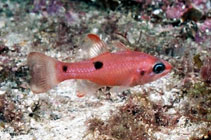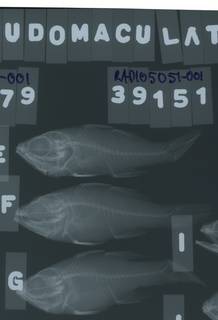WoRMS taxon details
Apogon pseudomaculatus Longley, 1932
159590 (urn:lsid:marinespecies.org:taxname:159590)
accepted
Species
marine, brackish, fresh, terrestrial
Longley, W. H. (1932). Preparation of a monograph on the Tortugas fishes. <em>Carnegie Institution of Washington Year Book.</em> 31: 299-301. [details]
Distribution Western Atlantic: from New England to Bermuda, and Bahamas to southern Brazil, including the Gulf of Mexico, larvae stray...
Distribution Western Atlantic: from New England to Bermuda, and Bahamas to southern Brazil, including the Gulf of Mexico, larvae stray into Canadian waters [details]
Froese, R. and D. Pauly. Editors. (2024). FishBase. Apogon pseudomaculatus Longley, 1932. Accessed through: World Register of Marine Species at: https://marinespecies.org/aphia.php?p=taxdetails&id=159590 on 2024-04-25
![]() The webpage text is licensed under a Creative Commons Attribution-Noncommercial 4.0 License
The webpage text is licensed under a Creative Commons Attribution-Noncommercial 4.0 License
original description
Longley, W. H. (1932). Preparation of a monograph on the Tortugas fishes. <em>Carnegie Institution of Washington Year Book.</em> 31: 299-301. [details]
context source (Deepsea) Intergovernmental Oceanographic Commission (IOC) of UNESCO. The Ocean Biogeographic Information System (OBIS), available online at http://www.iobis.org/ [details]
context source (Bermuda) Smith-Vaniz, W. F.; Collette, B. B.; Luckhurst, B. E (1999). Fishes of Bermuda: History, zoogeography, annotated checklist, and identification keys (American Society of Ichthyologists and Herpetologists - Special Publication No.4) . ASIH, 424 pp. [details]
basis of record Scott, W.B.; Scott, M.G. (1988). Atlantic fishes of Canada. <em>Canadian Bulletin of Fisheries and Aquatic Sciences.</em> No. 219. 731 pp. [details]
additional source Welshman, D.; Kohler, S; Black, J.; and L. Van Guelpen. (2003). An atlas of distributions of Canadian Atlantic fishes. , available online at http://epe.lac-bac.gc.ca/100/205/301/ic/cdc/FishAtlas/default.htm [details]
additional source McEachran, J. D. (2009). Fishes (Vertebrata: Pisces) of the Gulf of Mexico, Pp. 1223–1316 in: Felder, D.L. and D.K. Camp (eds.), Gulf of Mexico–Origins, Waters, and Biota. Biodiversity. Texas A&M Press, College Station, Texas. [details]
additional source Froese, R. & D. Pauly (Editors). (2023). FishBase. World Wide Web electronic publication. version (02/2023)., available online at https://www.fishbase.org [details]
ecology source Looby, A.; Erbe, C.; Bravo, S.; Cox, K.; Davies, H. L.; Di Iorio, L.; Jézéquel, Y.; Juanes, F.; Martin, C. W.; Mooney, T. A.; Radford, C.; Reynolds, L. K.; Rice, A. N.; Riera, A.; Rountree, R.; Spriel, B.; Stanley, J.; Vela, S.; Parsons, M. J. G. (2023). Global inventory of species categorized by known underwater sonifery. <em>Scientific Data.</em> 10(1). (look up in IMIS), available online at https://doi.org/10.1038/s41597-023-02745-4 [details]
context source (Deepsea) Intergovernmental Oceanographic Commission (IOC) of UNESCO. The Ocean Biogeographic Information System (OBIS), available online at http://www.iobis.org/ [details]
context source (Bermuda) Smith-Vaniz, W. F.; Collette, B. B.; Luckhurst, B. E (1999). Fishes of Bermuda: History, zoogeography, annotated checklist, and identification keys (American Society of Ichthyologists and Herpetologists - Special Publication No.4) . ASIH, 424 pp. [details]
basis of record Scott, W.B.; Scott, M.G. (1988). Atlantic fishes of Canada. <em>Canadian Bulletin of Fisheries and Aquatic Sciences.</em> No. 219. 731 pp. [details]
additional source Welshman, D.; Kohler, S; Black, J.; and L. Van Guelpen. (2003). An atlas of distributions of Canadian Atlantic fishes. , available online at http://epe.lac-bac.gc.ca/100/205/301/ic/cdc/FishAtlas/default.htm [details]
additional source McEachran, J. D. (2009). Fishes (Vertebrata: Pisces) of the Gulf of Mexico, Pp. 1223–1316 in: Felder, D.L. and D.K. Camp (eds.), Gulf of Mexico–Origins, Waters, and Biota. Biodiversity. Texas A&M Press, College Station, Texas. [details]
additional source Froese, R. & D. Pauly (Editors). (2023). FishBase. World Wide Web electronic publication. version (02/2023)., available online at https://www.fishbase.org [details]
ecology source Looby, A.; Erbe, C.; Bravo, S.; Cox, K.; Davies, H. L.; Di Iorio, L.; Jézéquel, Y.; Juanes, F.; Martin, C. W.; Mooney, T. A.; Radford, C.; Reynolds, L. K.; Rice, A. N.; Riera, A.; Rountree, R.; Spriel, B.; Stanley, J.; Vela, S.; Parsons, M. J. G. (2023). Global inventory of species categorized by known underwater sonifery. <em>Scientific Data.</em> 10(1). (look up in IMIS), available online at https://doi.org/10.1038/s41597-023-02745-4 [details]
 Present
Present  Present in aphia/obis/gbif/idigbio
Present in aphia/obis/gbif/idigbio  Inaccurate
Inaccurate  Introduced: alien
Introduced: alien  Containing type locality
Containing type locality
From other sources
Distribution Western Atlantic: from New England to Bermuda, and Bahamas to southern Brazil, including the Gulf of Mexico, larvae stray into Canadian waters [details]Habitat Commonly found on hard or semi-hard bottoms of the continental shelf; in harbors and around pilings and sea walls, out to outer reefs. [details]
Habitat nektonic [details]
Reproduction External fertilization, mouth brooders [details]
To Barcode of Life (18 barcodes)
To Biodiversity Heritage Library (8 publications)
To European Nucleotide Archive (ENA)
To FishBase
To FishBase images (Apogon pseudomaculatus, Brazil, by Luiz, Jr., O.)
To GenBank (15 nucleotides; 12 proteins)
To Global Biotic Interactions (GloBI)
To IUCN Red List (Least Concern)
To NMNH Extant Collection (Apogon pseudomaculatus P00905 illustration)
To NMNH Extant Collection (Apogon pseudomaculatus RAD105051-001)
To ITIS
To Biodiversity Heritage Library (8 publications)
To European Nucleotide Archive (ENA)
To FishBase
To FishBase images (Apogon pseudomaculatus, Brazil, by Luiz, Jr., O.)
To GenBank (15 nucleotides; 12 proteins)
To Global Biotic Interactions (GloBI)
To IUCN Red List (Least Concern)
To NMNH Extant Collection (Apogon pseudomaculatus P00905 illustration)
To NMNH Extant Collection (Apogon pseudomaculatus RAD105051-001)
To ITIS


